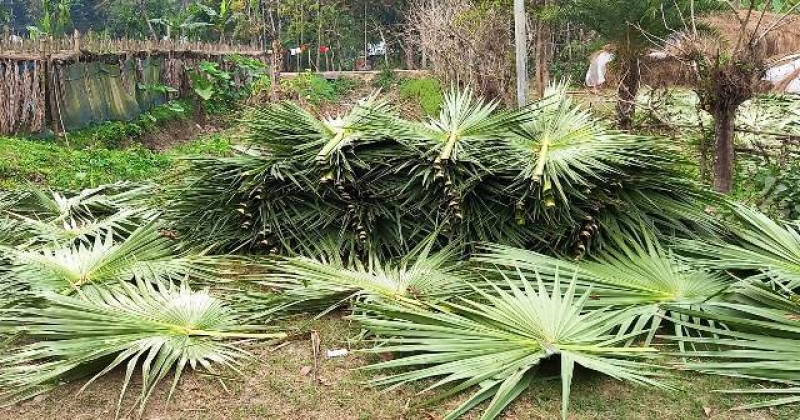- Rain, thundershowers likely over 8 divisions: BMD |
- First freight train leaves Mongla carrying molasses |
- 2 dead, six hurt in Sherpur micro-autorickshaw-motorbike crash |
- One killed over loud music row at wedding party in Natore |
- Fire breaks out at jacket factory in Chattogram |
Bagerhat artisans keep tradition up with ‘hatpakha’

Palm branches harvested to make hatpakha for the upcoming summer. Phoro UNB
Bagerhat, Feb 23 – Even in the digital age, the traditional 'talpakha' (handmade fan crafted from palm leaves) remains a staple in homes across Bangladesh, offering a natural respite from the summer heat.
Mansa village in Fakirhat upazila of Bagerhat district has long been synonymous with the craftsmanship of talpakha, and its artisans are currently busy producing these fans in anticipation of the hot season.
For many families, this age-old trade is not just a cultural heritage but a primary means of livelihood.
Within a few weeks, vibrantly coloured talpakha will adorn market stalls, fairs and rural haats, continuing a legacy passed down through generations.
A Heritage of Craftsmanship
A recent visit to Mansa village under Bahirdia-Mansa union revealed artisans diligently engaged in the intricate production process. Raw palm leaves of various sizes were being cut, dried in open courtyards, and methodically processed for crafting.
Fields and homesteads were dotted with stacks of sun-dried leaves, while rickshaw vans transported fresh batches from neighbouring areas.
Once dried, the leaves undergo careful trimming before being transformed into talpakha through the skilful hands of craftsmen and women.
The palm tree holds deep cultural significance in Bangladesh, featuring prominently in folk songs, poetry, and rural traditions.
Beyond its symbolic value, it provides the essential raw material for a craft that has endured the test of time.
Enduring Demand for Handmade Fans
Nayon Fakir, a veteran craftsman from Mansa, shared that at least 10 families in the village are directly involved in talpakha-making, a trade inherited from their forefathers.
“The fans crafted in our village are renowned for their quality, and demand remains high in markets,” he said.
Production starts in the Bengali month of Falgun (mid-February), with initial preparations currently in full swing. Within days, the finished products will be ready for sale.
Explaining the process, Nayon said that raw palm leaves are first purchased, dried in the sun for a day, and then exposed to dew overnight.
The dried leaves are subsequently cut to size and stacked. Bamboo, thread, and colours are used to assemble the fans, which pass through multiple stages before completion.
“We manufacture fans in various sizes according to wholesale orders,” he added.
The raw palm leaves cost between Tk 5 to Tk 7 per piece. Once crafted into talpakha, the finished fans are sold to wholesalers at prices ranging from Tk 12 to Tk 35 per piece, depending on size. In retail markets, they fetch between Tk 30 and Tk 60, varying in size and quality.
“Our entire livelihood depends on this craft,” Nayon said.
A Seasonal Livelihood for Many
Md Rajib Sheikh, another skilled artisan, explained that their families engage in fan-making from Falgun until mid-June.
“We receive large orders from wholesalers, and craftsmen of all ages work tirelessly to meet demand,” he said.
Each family produces between 25,000 and 30,000 fans during this period, generating earnings between Tk 2 lakh and Tk 2.50 lakh.
“This trade has been in our family for generations, sustaining numerous households in our village,” he added.
Despite the widespread availability of electric fans, talpakha remain a popular alternative, particularly in rural areas where they are favoured for their affordability and effectiveness.
As summer approaches, the demand for these handmade fans continues, ensuring that this time-honoured craft remains relevant even in the modern era.
Keeping Tradition Alive
For many artisans in Mansa, talpakha-making is more than a seasonal occupation; it is a cherished heritage they proudly uphold.
While technological advancements have reshaped daily life, the enduring appeal of these handmade fans stands as a testament to the resilience of tradition in Bangladesh’s heartland. - UNB

